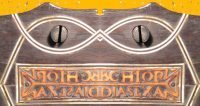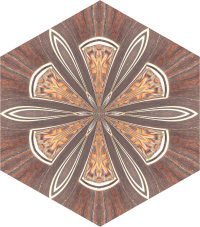 |
Do Regimento dos Violeiros 1572*
E o official do dito officio que tenda houver de ter faraa hua viola de seis ordens de costilhas de pao preto ou vermelho laurada de fogo muito bem moldada e laurada:
And the owner of such shop(1) would have to make a six-course viola with sides(2) of black or red wood, bent over ‘hot iron’ to the appropriate shape.
tampão e fundo de duas metades ?ss? junta pelo meo muita bem feita: e marchetada cõ hu marchete de oito e outro de quatro muito bem feitos:
The front and the back each made of two pieces joined in the middle and adorned, accordingly, with eight and four(3) pieces of inlay.
e pelo pescoço arriba leuara hu rotolo ou hua trena cõ huas encaixaduras cõ seus remates e seraa grudada cõ grude de pexe:
And at the end of the neck (i.e. peg head) bearing a maker’s label or [decorative strip / ornament](4), with all the joints fixed with fish glue.
fundo e tampão, e seraa forrada per dentro cõ forros de panno:
The back and the soundboard lined from the inside with strips of cloth(5).
Item faraa hu laço de talha fundo ou raso muito bem feito:
Item to make a good quality carved (or cut?) rose of either deep or shallow type.
Item regrara muito bem a dita viola e a alimpara e per esta manrª seraa acabada:
Item to complete the set-up and cleaning of the viola and finishing the job by the next morning.
Item encordada a dita viola muito bem segundo pertencer ao tamanho della, e a[ha]pontara e afinara de maneira que possão nella tanger [?]:
Item to string the viola with a set of strings appropriate to its size and tune it up so as to make it playable.
Item mandão que os violeiros que tenda teuerem que fação as violas de seis ord?s de duas costilhas: e seião forradas cõ pions ou lenços:
Item requiring violeros to make a six-course viola with sides consisting of two strips(6) and re-enforce them (from the inside) with pieces of pine or linen (strips).
e os laços dellas de talha seião de folha: e se os quiserem fazer no tampão ão forrados de purgaminho.
And with carved (or cut?) layered (multi-layer) roses which have to be lined with parchment before being inserted in the soundboard(7).
 |
* Do Regimento dos Violeiros of 1572 is a part of the Liuro dos Regimentos dos officiaes mecanicos … Ano. MDLxxij, fol. 157 – 159. It lists the prescribed order of rules and procedures that the violeros (vihuela makers) must follow in their business practice. For the purpose of this translation I divided the text in sections so that each of them deals with more or less one step in the vihuela construction process.
I would like to express my sincere gratitude to John Griffiths for providing me with the text of the Regimento dos Violeiros , as well as to Manuel Morais who hand-copied it so carefully from the original document. Also to Ariel Abramovich for helping me to get to grips with basics of Portuguese sentence structure.

(1) In other words, a violero who has to pass the examination procedure in order to be qualified as possessing a sufficient amount of skills to start his own business as an independent vihuela maker.
(2) Viola is the Portuguese equivalent of vihuela. Note that costilhas in the context of this particular document signify the sides, not the ribs of the back of the instrument, as seems to have been implied in some articles dedicated to the study of the vihuela in which this sentence has been quoted.
(3) Neither of the existing pictorial representations of the vihuela shows the backs of the instruments and so we have no idea if they were decorated in some similar way to the soundboards (for example, with mosaic inlays as those in the soundboard of the Jaquemart-Andre vihuela or in the style shown on the vihuela illustrations in L.Milan’s El Maestro).
(4) Trena (from Latin trina, triple). One plausible way of interpreting trena in the context of this sentence is as in its Spanish equivalent - trenza (engl. plait, braid) which resembles twisting and interweaving plait- / rope-like decorative patterns on the peg heads and fingerboards of both the Dias vihuela and an anonymous Portuguese c.1590 guitar from the former collection of Robert Spencer (in the case of the Dias vihuela there is also a maker’s label inlayed in the peg head veneer). Similar plait-resembling decorative patterns are also found on a number of surviving Spanish and Portuguese guitars (for example, on the fingerboard and peg head of a six-course viola by Antonio dos Santos Vierra from the Ashmolean Museum, Oxford).
(5) Linen strips re-enforcing the joints between the ribs of the back are found in the Dias vihuela (see also footnote 6 below). In one of the earliest to date surviving Spanish guitars attributed to F. Sanguino (c. 1760 - 70), linen strips appear not only over the joints of the back and sides but also on the underside of the soundboard, across its width, in front and behind the bridge.
(6) Here there is an important distinction from the viola mentioned in the first sentence (see also footnote 2), which seems to imply that the sides are constructed of whole-strips of wood. It may well be that the practice of using two (or more?) strips of wood for the sides was a fairly common practice for simply practical reasons of utilizing shallower pieces of wood. And it is interesting to see that the skills required to make a viola with such sides as well as the ways of securing the joints with strips of linen and / or pieces of pine - pions (small glue blocks or peones as they are known in the Spanish tradition of guitar construction) was included, as a separate step, in the examination procedure.
The above-mentioned Sanguino guitar (see the footnote 5 above) has its sides made of two joined together pieces of cypress (one of them is about one third in width of the other), seemingly for no other purpose but to achieve the required width (all surviving guitars by this maker have remarkably wide sides).
The Dias vihuela, which was finished just nine years later after the text of the Regimento was compiled, can, in fact, serve as a surviving illustration of all the techniques mentioned in the document: double-strip sides with linen strip re-enforcement over the joint, as well as combination of linen strips and pine blocks securing the joints in-between the ribs of the back.
Double-strip sides divided with either a single line of wood of contrasting colour or a triple-line purfling appear to be as an inherent feature of the Spanish guitar construction from the late-18th to the early 19th century (for example on guitars of such distinguished makers as Juan and Josef Pages, Josef Benedid and many others).
(7) This particular step seems to describe the process of making a multi-layered wood and parchment rose.
 |
This page was last updated 17 September 2006
© 2006 Alexander Batov